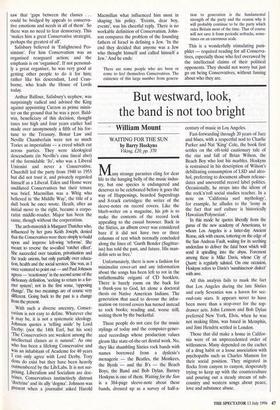But westward, look, the band is not too bright
• William Mount
WAITING FOR THE SUN by Barry Hoskyns Viking, £20, pp. 370
Many strange parasites cling for dear life to the hanging belly of the music indus- try, but one species is endangered and deserves to be celebrated before it goes the way of Happenings, bearded Superdrugs and 8-track cartridges: the writer of the sleeve-notes on record covers. Like the blurb-writer on a magazine, his job is to make the contents of the record look appealing to the casual browser. Back in the Sixties, an album cover was considered bare if it did not have two or three columns of text which normally concluded along the lines of: 'Garth Bender (Sagittar- ius) has told the past, and future. His man- dolin sets us free.' .
Unfortunately, there is now a fashion for minimalist cover-art and any information about the songs has been left to rot in the unfathomable origami of CD booklets. There is barely room on the back for a thank-you to God, let alone a doctoral thesis on Native American Indians. The generation that used to devour the infor- mation on record covers has turned instead to rock books; reading and, worse still, writing them by the bucketful.
These people do not care for the music stylings of today and the computer-gener- ated recordings whose production values gleam like state-of-the-art dental work. No, they like shambling Sixties rock bands with names borrowed from a dyslexic's menagerie — the Beatles, the Monkees, the Byrds — and the B's — the Beach Boys, the Band and Bob Dylan. Barney Hoskyns is one of them. Waiting for the Sun is a 384-page sleeve-note about these bands, dressed up as a survey of half-a-
century of music in Lot Angeles. Fast-forwarding through 20 years of Jazz and blues, with a respectful nod to Charlie Parker and Nat 'King' Cole, the book first settles on the oft-told cautionary tale of the rise and fall of Brian Wilson, the Beach Boy who lost his marbles. Hoskyns is restrained in his description of Wilson's debilitating consumption of LSD and alco- hol, preferring to document album release- dates and uneventful record label politics. Occasionally, he strays into the idiom of the rock'n'roll social studies teacher. In a note on 'California surf mythology', for example, he alludes to the 'irony in the fact that surf culture is historically Hawaiian/Polynesian'.
In this mode he quotes hberally from the gurus of the new academy of Americana, to whom Los Angeles is a latter-day Ancient Rome, sick with excess, tottering on the edge of the San Andreas Fault, waiting for its seething underclass to deliver the fatal boot which will send it spiralling into the abyss. Foremost among these is Mike Davis, whose City of Quartz is regularly saluted. On one occasion, Hoskyns refers to Davis's 'sunshine/noir dialect' with awe.
All this analysis fails to mask the fact that Los Angeles during the late Sixties and early Seventies was a haven for sec- ond-rate stars. It appears never to have been more than a stop-over for the top- drawer acts. John Lennon and Bob Dylan preferred New York, Elvis, when he was not making films, was based in Memphis, and Jimi Hendrix settled in London.
Those that did make a home in Califor- nia were of an unprecedented order of witlessness. Many depended on the cachet of a drug habit or a loose association with psychopaths such as Charles Manson for their social position. They migrated in flocks from canyon to canyon,- desperately trying to keep up with the counterculture and pouring out a steady stream of sub- country and western songs about peace, love and substance abuse.


































































 Previous page
Previous page